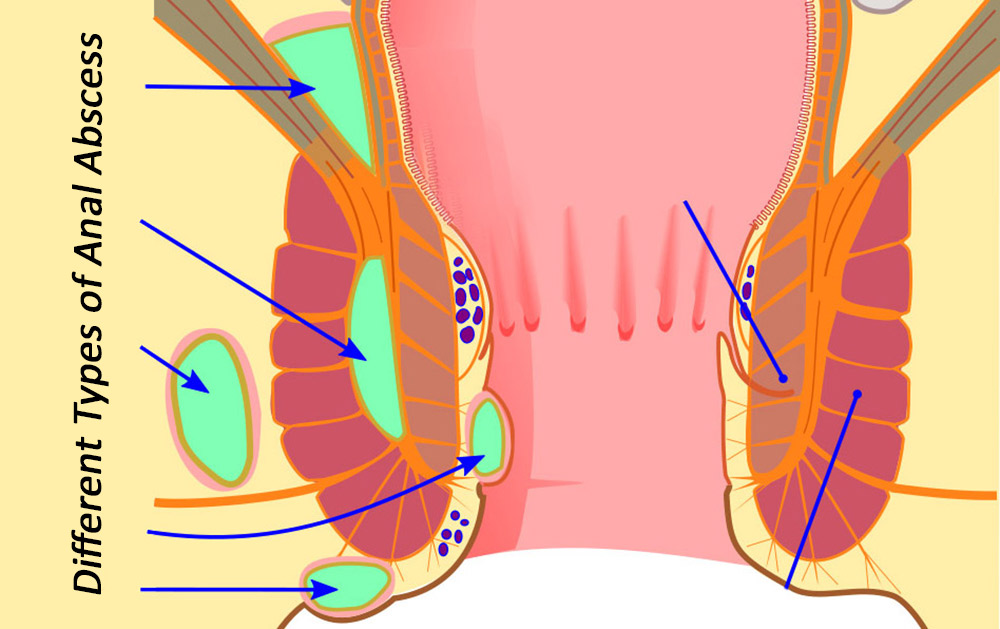There are different types of anorectal or anal diseases. A general surgeon can diagnose all these diseases through examinations or tests. The most prevalent anal diseases are hemorrhoids or piles, anal fissures, anorectal abscesses, and anal fistula. Since the anus and the surrounding area are always active and infected, it is recommended to seriously follow up any suspicious symptoms by visiting a specialist to prevent anorectal diseases.

Anal itching and irritation
There are different causes of anal itching and irritation. These symptoms may be primarily due to constipation, wearing tight or plastic clothes, subcutaneous hair, digestive diseases and worms, or various types of fungi. It is recommended to take necessary actions to treat these symptoms at early stages. If these symptoms remain untreated, they may progress into more advanced diseases.
Anal abscess
An anal abscess is caused by infections or blockage of anal glands. Sexually transmitted diseases or gastrointestinal disorders, such as Crohn’s disease and diverticulitis, can also cause anorectal abscesses. In addition, an untreated anal fissure may get infected and eventually lead to an anal abscess. Anal abscesses can be very dangerous if they are treated. The symptoms of anal abscesses are anal pain, constipation, and fever. The standard treatment for anal abscesses is surgery, especially by using laser equipment.

Anal fistula
An anal fistula or anorectal fistula is a small infected tunnel that develops between the anus and the skin near the anus. An anal fistula also refers to a chronic infection in the anal gland that spreads to the skin. Symptoms of an anal fistula are pain, inflammation, and discharge of pus and blood. Surgery is the most common treatment of anal fistula. However, the best treatment is laser surgery because it does not cause anal incontinence. It is noteworthy that the success of this treatment heavily depends on the surgeon’s proficiency and experience.
Pilonidal sinus
Pilonidal sinus is a common anorectal disease that usually occurs at the end of the sacrum. Most patients with a pilonidal sinus have thick hair on the buttocks. The main cause of pilonidal sinus is the return of hair towards the skin. This disease has no symptoms other than a bulge in the early stages; when a pilonidal sinus gets infected, other symptoms such as pain, inflammation, and redness appear. However, small holes and purulent discharges are indicative of pilonidal sinus in more advanced stages of the disease. The best treatment of pilonidal sinus is closed laser surgery using a high-power laser by an experienced and proficient general surgeon and laser surgery specialist. Pilonidal sinus cannot be treated by medication, but it should be removed and drained through conventional surgery or laser surgery. Otherwise, it constantly recurs and gets infected. If a pilonidal sinus remains untreated, frequent infections fistulate the pilonidal sinus and, as a result, the area is further damaged.
Different types of anal warts
Warts are usually caused by a virus. Human papillomavirus (HPV) is the cause of the most common anal and genital warts. In addition, HPV is responsible for 2% of cancers. Some dangerous strains of this disease lead to cervical, penile, and laryngeal cancers. This disease is highly contagious and is often transmitted to patients during high-risk sex. Individuals who have multiple sexual partners or experience unprotected sex are at greater risk to develop genital warts. Patients with genital or anal warts usually use ointments, cryotherapy, or high-power laser therapy to remove the skin tags caused by warts. However, the removal of wart tags is not a definitive treatment, and the patient will always be a carrier of the virus.
Hemorrhoids or piles
Hemorrhoids or piles are natural veins that facilitate defecation. Pressure or improper nutrition can make these veins bulged, painful, and abnormal. There are different types of hemorrhoids. Internal hemorrhoids occur inside the anus and may be asymptomatic until they protrude from the anus and get prolapsed. External hemorrhoids occur out of the dentate line and usually appear as thrombosed hemorrhoids.

Fissure
An anal fissure is a small tear in the thin, moist tissue that lines the anus. An anal fissure may occur when you pass hard or large stools during a bowel movement or when you suffer from constipation. Symptoms of fissures are pain or bleeding with bowel movements or anal irritation. This condition generally has no specific symptom. You can easily improve this disease by practicing good hygiene and following a high-fiber diet for 4 to 6 weeks. Laxatives and anti-fissure ointments can be also effective in treating anal fissures.

